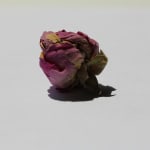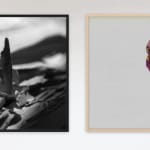

Leila Zelli
Les paysages sacrés, 2018
Impression numérique sur papier Hahnemuhle Rag Baryta / Digital print on Hahnemuhle Rag Baryta
23 1/2 x 35 1/2 " chacune / each
59.7 x 90.2 cm
La série 'Les paysages sacrés' se présente sous forme de diptyques. Les agencements de ceux-ci peuvent se faire au goût du client et selon la forme suivante; une œuvre photographique du vieux Coran pour une œuvre photographique de la rose de Damas. Les encadrements sont préétablis selon le choix de l’artiste soit en érable blanchi et en érable teint. Veuillez nous contacter afin de faire l’agencement de votre choix. / The 'Sacred Landscapes' series is presented in the form of diptychs. The arrangements of these can be made according to the taste of the customer and according to the following form: a photographic work of the old Koran for a photographic work of the rose of Damascus. The frames are pre-established according to the choice of the artist either in whitewashed maple or in stained maple. Please contact us to make the arrangement of your choice.
59.7 x 90.2 cm
La série 'Les paysages sacrés' se présente sous forme de diptyques. Les agencements de ceux-ci peuvent se faire au goût du client et selon la forme suivante; une œuvre photographique du vieux Coran pour une œuvre photographique de la rose de Damas. Les encadrements sont préétablis selon le choix de l’artiste soit en érable blanchi et en érable teint. Veuillez nous contacter afin de faire l’agencement de votre choix. / The 'Sacred Landscapes' series is presented in the form of diptychs. The arrangements of these can be made according to the taste of the customer and according to the following form: a photographic work of the old Koran for a photographic work of the rose of Damascus. The frames are pre-established according to the choice of the artist either in whitewashed maple or in stained maple. Please contact us to make the arrangement of your choice.
Ed. 3 - Le prix inclus deux oeuvres non encadrées. / The price includes two unframed works.
Series: Les paysages sacrés
© Leila Zelli
Leila Zelli s’intéresse aux rapports que l’on entretient avec l’idée « d’autres » et « d’ailleurs » et plus spécifiquement au sein de cette espace géopolitique souvent désigné par le...
Leila Zelli s’intéresse aux rapports que l’on entretient avec l’idée « d’autres » et « d’ailleurs » et plus spécifiquement au sein de cette espace géopolitique souvent désigné par le terme discutable de « Moyen-Orient ». Elle crée des installations in situ fruit d’une réactivation artistique d’images et de vidéos souvent glanés sur internet et les réseaux sociaux. En résultent des expériences visuelles et sonores qui suscitent un moment de réflexion sur l'état du monde, sur le rapport à l’Autre et sur la portée effective de nos gestes sur l’humanité.
À première vue, le contenu du travail n’est jamais clair, le spectateur fait toujours face à une dualité ou à une juxtaposition qui l’oblige, elle l’espère, à voir que toute interprétation des images dépend du point de vue qu’on occupe, de notre expérience de vie, de nos croyances, et encore de notre volonté de voir ou de notre désir d’ignorer ce qui est.
Dans 'Les paysages sacrés' (2018), deux séries d’images entrent d’abord en relation par une rime structurelle (les mêmes angles, profondeurs, excroissances, mises au foyer) et par un contraste esthétique (le noir et blanc/la couleur, la lumière crue/la douceur). Elles présentent d’une part les plis du vieux Coran de la grand-mère de l’artiste, de l’autre, les pétales secs d’une rose de Damas rapportée de voyage par sa mère (la guerre initiée par le groupe armé État islamique est en train de faire disparaître cette fleur originaire de Syrie). La relation entre les photos n’est évidemment pas seulement formelle, elle soulève de manière subtile, presque souterraine, le questionnement de la relation entre la religion et la guerre.
____________
Leila Zeila is interested in the relationship we have with the idea of "others" and "elsewhere" and more specifically within this geopolitical space often referred to by the debatable term "Middle East". She creates site-specific installations that are the result of an artistic reactivation of images and videos often gleaned from the internet and social networks. The result is visual and sound experiences that provoke a moment of reflection on the state of the world, on the relationship to the Other and on the effective impact of our actions on humanity.
At first glance, the content of the work is never clear, the viewer is always faced with a duality or juxtaposition that hopefully forces them to see that any interpretation of the images depends on the point of view we occupy, our life experience, our beliefs, and again our willingness to see or our desire to ignore what is.
In 'Sacred Landscapes' (2018), two sets of images first enter into a relationship through structural rhyme (the same angles, depths, outgrowths, focus) and aesthetic contrast (black and white/color, harsh light/softness). On the one hand, they present the folds of the artist's grandmother's old Koran, on the other, the dry petals of a Damascus rose brought back from a trip by her mother (the war initiated by the armed group Islamic State is wiping out this flower native to Syria). The relationship between the photos is obviously not only formal, it raises in a subtle, almost subterranean way, the questioning of the relationship between religion and war.
À première vue, le contenu du travail n’est jamais clair, le spectateur fait toujours face à une dualité ou à une juxtaposition qui l’oblige, elle l’espère, à voir que toute interprétation des images dépend du point de vue qu’on occupe, de notre expérience de vie, de nos croyances, et encore de notre volonté de voir ou de notre désir d’ignorer ce qui est.
Dans 'Les paysages sacrés' (2018), deux séries d’images entrent d’abord en relation par une rime structurelle (les mêmes angles, profondeurs, excroissances, mises au foyer) et par un contraste esthétique (le noir et blanc/la couleur, la lumière crue/la douceur). Elles présentent d’une part les plis du vieux Coran de la grand-mère de l’artiste, de l’autre, les pétales secs d’une rose de Damas rapportée de voyage par sa mère (la guerre initiée par le groupe armé État islamique est en train de faire disparaître cette fleur originaire de Syrie). La relation entre les photos n’est évidemment pas seulement formelle, elle soulève de manière subtile, presque souterraine, le questionnement de la relation entre la religion et la guerre.
____________
Leila Zeila is interested in the relationship we have with the idea of "others" and "elsewhere" and more specifically within this geopolitical space often referred to by the debatable term "Middle East". She creates site-specific installations that are the result of an artistic reactivation of images and videos often gleaned from the internet and social networks. The result is visual and sound experiences that provoke a moment of reflection on the state of the world, on the relationship to the Other and on the effective impact of our actions on humanity.
At first glance, the content of the work is never clear, the viewer is always faced with a duality or juxtaposition that hopefully forces them to see that any interpretation of the images depends on the point of view we occupy, our life experience, our beliefs, and again our willingness to see or our desire to ignore what is.
In 'Sacred Landscapes' (2018), two sets of images first enter into a relationship through structural rhyme (the same angles, depths, outgrowths, focus) and aesthetic contrast (black and white/color, harsh light/softness). On the one hand, they present the folds of the artist's grandmother's old Koran, on the other, the dry petals of a Damascus rose brought back from a trip by her mother (the war initiated by the armed group Islamic State is wiping out this flower native to Syria). The relationship between the photos is obviously not only formal, it raises in a subtle, almost subterranean way, the questioning of the relationship between religion and war.

